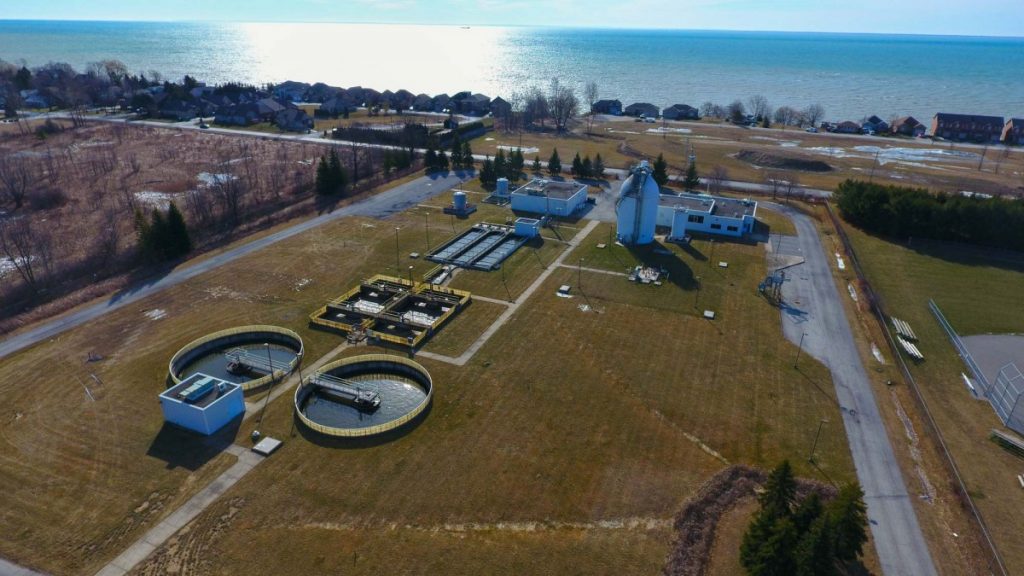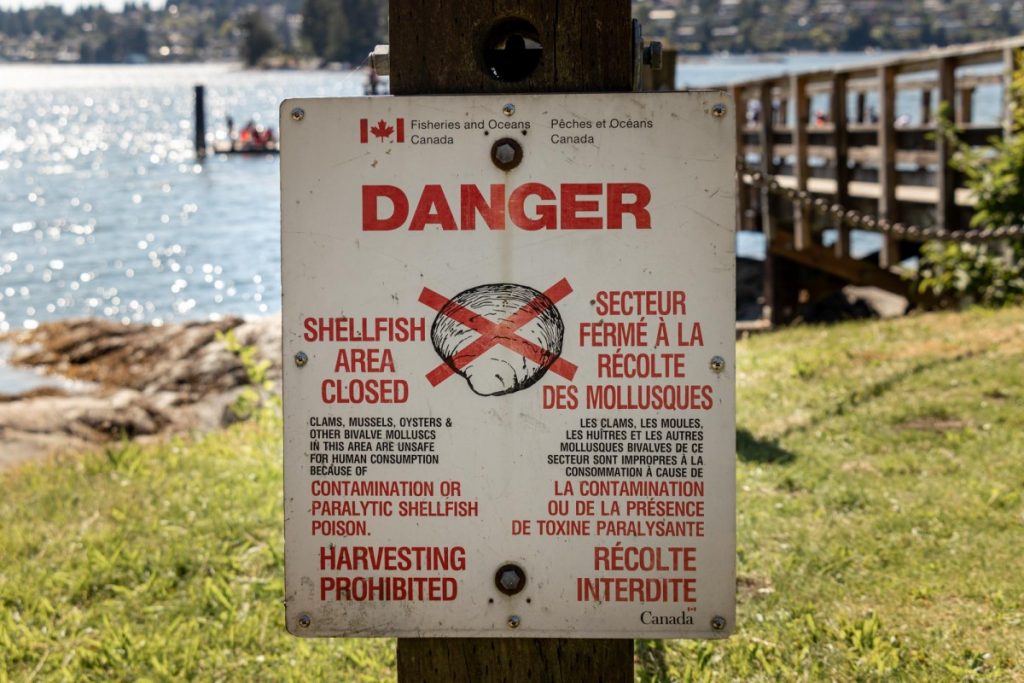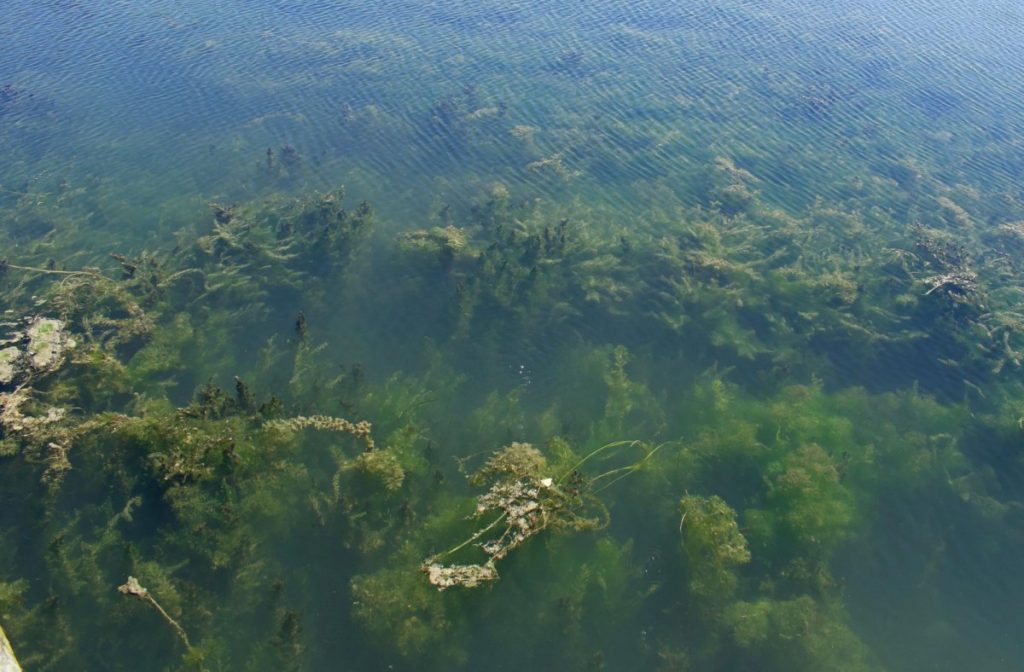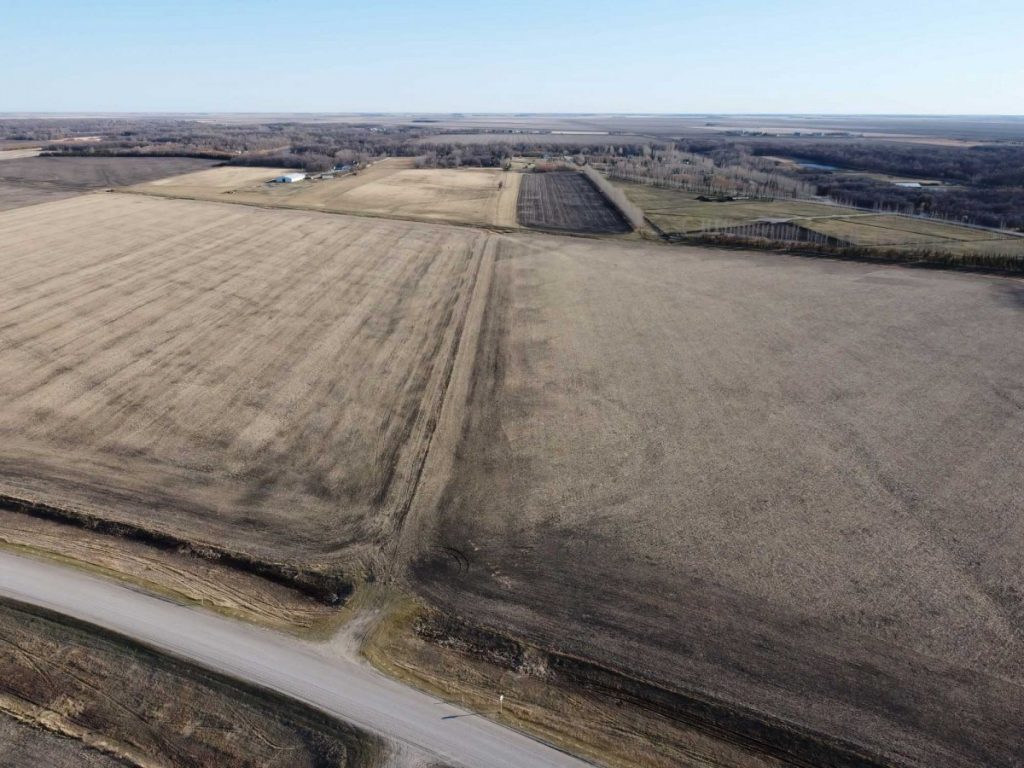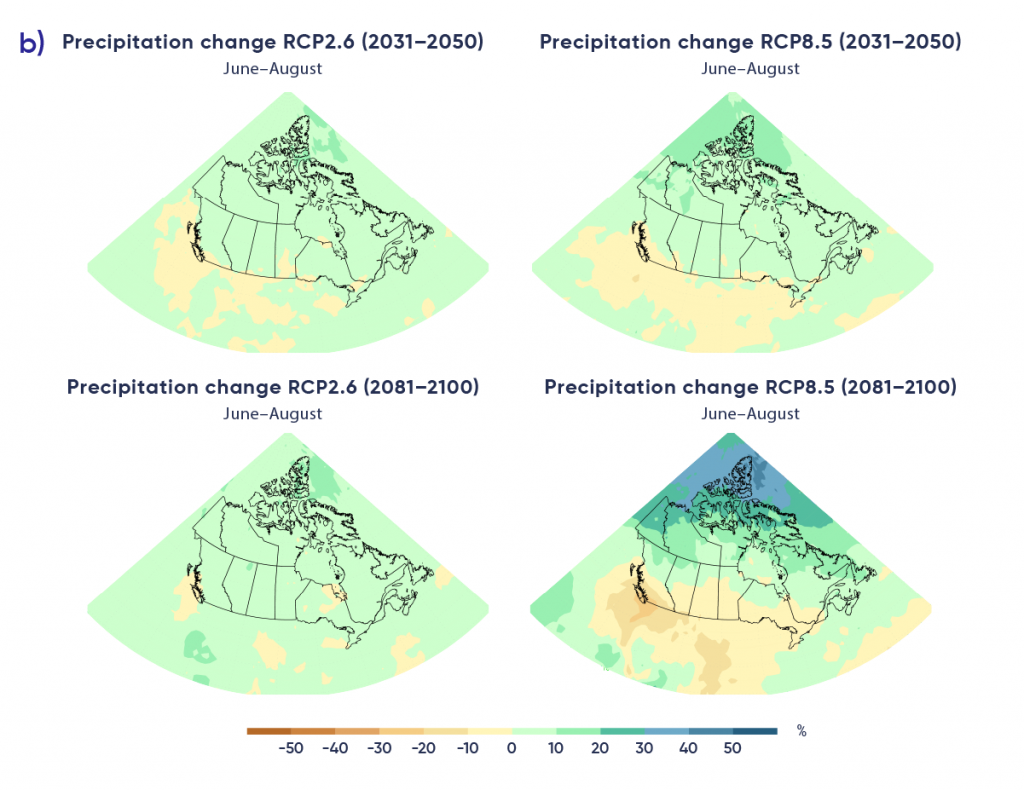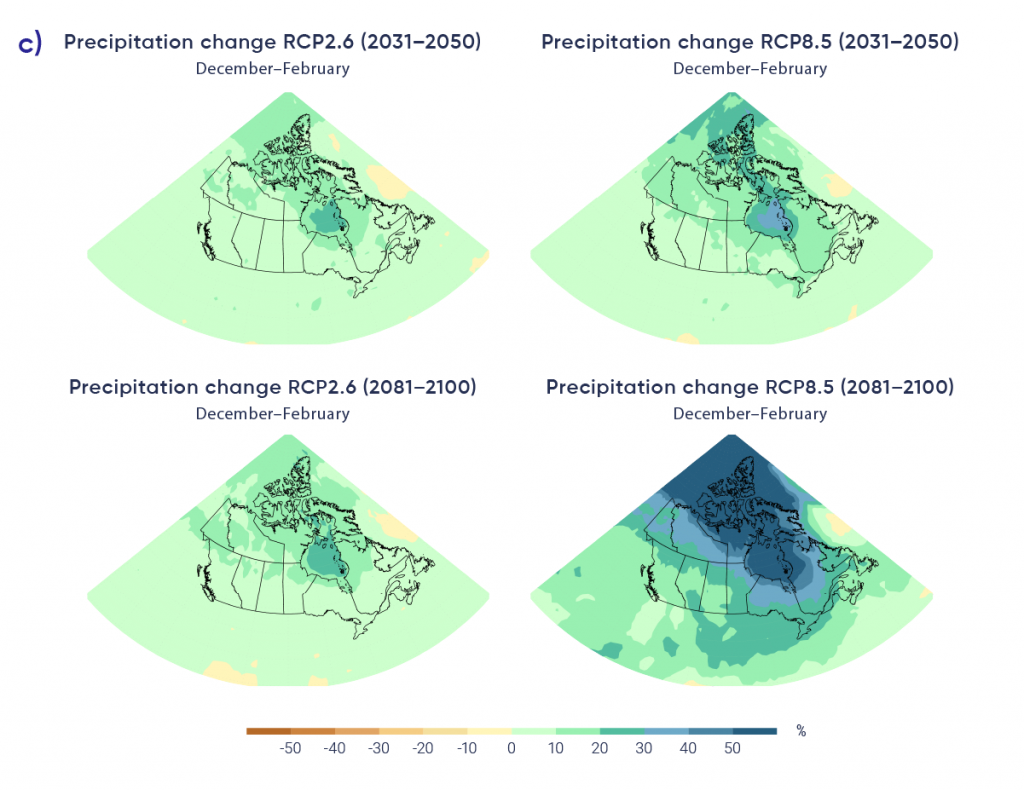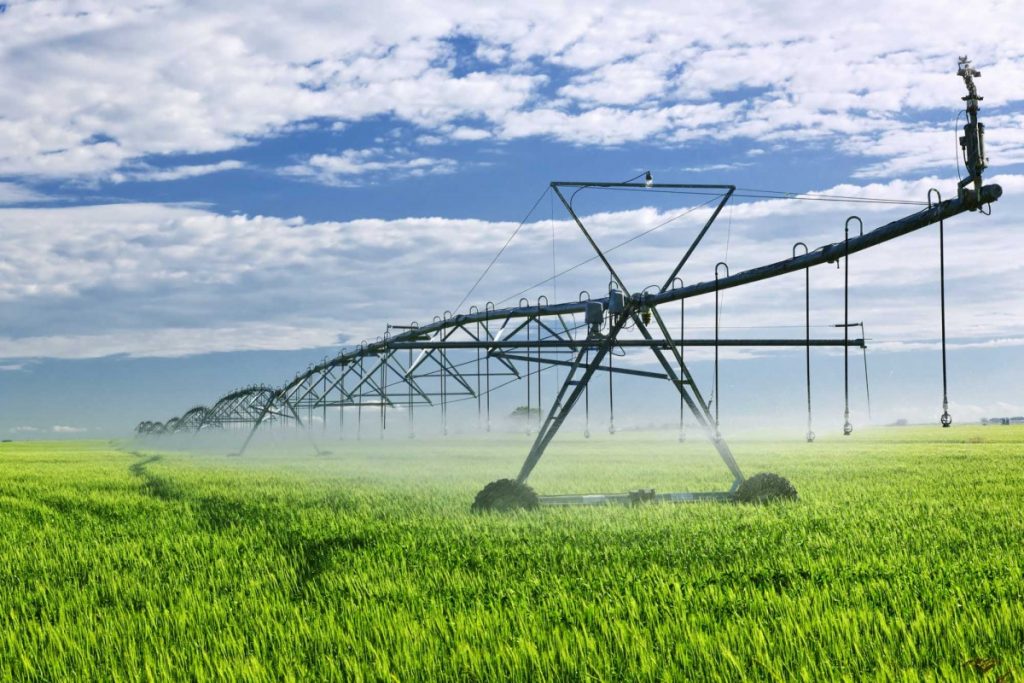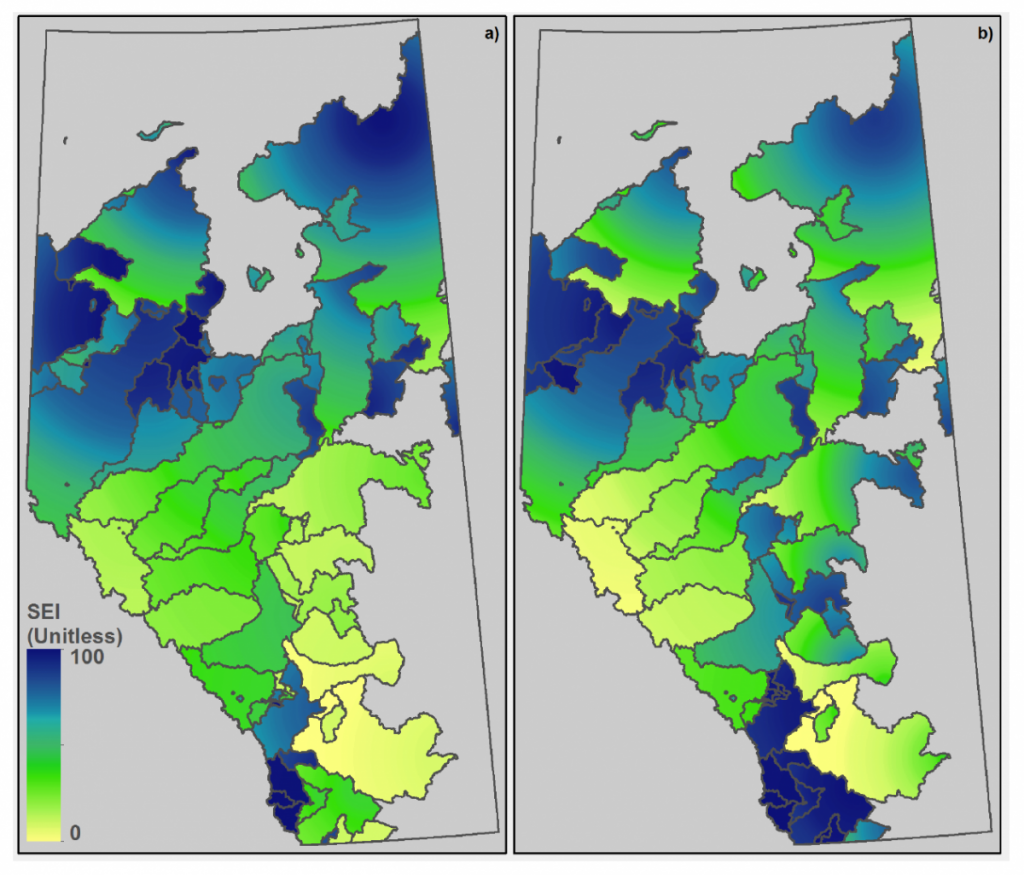Water security has direct implications for drinking water and water systems, food and food systems, cultural and spiritual practices, and recreation. Access to drinking water of a suitable quality and in sufficient supply to sustain health and well-being is a core component of water security. Similarly, water is fundamental to both food production (e.g., crop irrigation, maintaining healthy fish stocks, etc.) and food processing (e.g., manufacturing processed foods, cleaning vegetables before distribution for sale, cooking, etc.). Air temperature, water temperature, and precipitation are the most important climatic variables influencing the occurrence of food-borne disease (Smith & Fazil, 2019) (see Chapter 8: Food Safety and Security). Of the 11 key food-borne pathogens identified by Smith and Fazil (2019) to examine in the context of climate change in Canada, six are influenced, in part, by precipitation, drought, and/or water temperature.
Parts of Canada already face periods of water insecurity, due to impacts on water quality and shortages in water supply. For example, in 2019, Iqaluit, Nunavut, faced an unprecedented shortage of source water after a summer of historically low precipitation (Bell, 2019). As the climate continues to warm, and in the absence of effective adaptation measures, concerns related to water security and human health may increase. Public health and water management practitioners, researchers, and decision makers all have a role to play in protecting and promoting health by working to attain and/or maintain water security.
7.3.4.1 Water and the Food System
Water, in a sufficient supply and of a sufficient quality, is critical to food production and is also used for cleaning, sanitation, and manufacturing activities in the food system (Kirby et al., 2003). Food processing operations require very large amounts of water (Compton et al., 2018). Variability in water supply could disrupt food -processing activities, with long-term disruptions affecting food security. Water may also serve as a vehicle for transmission of chemical and/or microbial contamination of foods during processing (Kirby et al., 2003). Key pathways by which climate change can affect food processing via water impacts include increasing frequency and length of drought periods, which may result in reduced access to water required for processing activities; flooding agricultural fields with contaminated water; and contaminating water used in food processing, such as through floodwater washing contaminants into water sources (Delpla et al., 2009; Schnitter & Berry, 2019). Impacts through any of these routes would necessitate alterations to current Hazard Analysis Critical Control Point (HACCP) steps used to prevent food-borne illness in Canada (CFIA, 2012). Food businesses in Canada are required to have a food safety plan, and the HACCP is a key tool for developing one. In the HACCP approach, water is used for food processing and cleaning, removing chemical and microbial contaminants on meat, produce, or other raw ingredients.
Water serves as a potential vehicle for the direct transmission of chemical and microbial contaminants to foods during processing. Chemical contaminants can include heavy metals, household and industrial pollutants, pesticides, and nitrates. Microbial contaminants can include pathogenic bacteria, such as verotoxigenic Escherichia coli, parasites such as Toxoplasma gondii, protozoa such as Cryptosporidium, and viruses such as norovirus. As noted in previous sections, extreme weather events associated with climate change can promote the movement of chemicals and pathogens from the surrounding environment into source water at higher levels than usual, potentially overwhelming existing treatment methods.
Both municipally treated and privately sourced water are used in food processing. Such water sources are generally treated for selected chemical and microbial hazards but are not risk-free (Kirby et al., 2003). Water that is untreated or ineffectively treated before use in food processing can transmit contaminants directly to foods. Food-borne disease outbreaks have been traced back to use of contaminated water during food processing (Kirby et al., 2003). Even water containing extremely low levels of a pathogen could result in hazardous exposures to humans via food. Given optimal conditions, transfer of just one pathogen cell to food could result in an infectious dose reaching the consumer, as the pathogen can grow from the period of food processing through distribution, retail, and storage to consumption (see Chapter 8: Food Safety and Security). Using common food processing methods, it is very difficult to completely inactivate all possible pathogens. Some food products, such as leafy greens, are more likely to cause illness, because of the minimal processing involved and the increased likelihood that they will be eaten raw (Jung et al., 2014). Given that small and private DWSs are already associated with water-borne disease outbreaks to a greater extent than larger systems, food processors serviced by such systems are at greater risk (Moffatt & Struck, 2011).
In addition to food contamination from use of water containing harmful pathogens, water shortages may also affect the processing of foods such as meat and produce, both of which have been linked to microbial food-borne disease outbreaks in Canada (Ravel et al., 2009). Water shortages can affect human health through compromised ability to remove contaminants from food; for example, limitations to the use of water for cleaning and sanitizing could result in less efficient removal of contaminants. During periods of low water availability, if alternative interventions or procedures to process foods are unavailable, reduced access to safe, nutritious food could compromise food security and affect human health.
The risk to food processing from water shortages has a seasonal component and is highest during the summer, when water demand for all purposes is greatest (Wiener et al., 2016). This time of year is also optimal for survival of many pathogens in the environment, as higher temperatures support and encourage growth (Smith & Fazil, 2019). While risks to food processing are highest in Southern Canada, depending on food exportation and supply chains, local or regional impacts on food processing from water shortages may be felt nationally.
Nearly 30% of food consumed in Canada is imported from other countries, with the majority of imported food coming from the United States (Statistics Canada, 2009). Climate change impacts on water availability and quality can also affect processing of foods in other countries that export food to Canada. These impacts are specific to the region, commodity, and possible contaminants and could ultimately have an impact on public health in Canada.
7.3.4.1.1 Fishing and Seafood
Climate change is expected to affect marine food sources, through temperature effects on marine ecosystems (e.g., changes in micro-biota and other species higher in the food web), ocean acidification, extreme precipitation events, and subsequent agricultural runoff linked to nutrient loading. The consumption of contaminated raw or undercooked fish and shellfish carries the risk of infection from viruses, bacteria, parasites, and toxins.
Vibrio species are naturally occurring bacteria found in ocean water worldwide, including Canada’s Pacific and Atlantic coastal waters. Common species on the Pacific and Atlantic coasts include V. parahaemolyticus (Vp), V. vulnificus, V. fluvialis, V. alginolyticus and non-toxigenic V. cholerae (Banerjee et al., 2018). Vp is the most common species linked to shellfish-related illness in Canada. If ingested, Vp can lead to diarrhea, vomiting, nausea, and fever lasting one to seven days, and, in rare cases, to death (BC CDC, 2020). The majority of Vp infections are caused by the consumption of raw oysters obtained from commercial fisheries or self-harvested. Other routes of exposure include inadvertently or submerging wounds or ears in contaminated ocean water or swallowing it.
Vp and other Vibrio species in bivalve shellfish on the Pacific and Atlantic coasts of Canada increased between 2006 to 2009 and 2010 to 2013 (Banerjee et al., 2018). Every year, 30 to 70 human infections are reported in British Columbia, as are a small number from other parts of the country (BC CDC, 2020). For every case of Vp reported in Canada, 92 additional cases are believed to have occurred in the affected community (Thomas et al., 2013). V. fluvialis and V. alginolyticus each result in zero to four locally acquired cases per year in British Columbia (Khaira & Galanis, 2007; BC CDC, 2020) which typically present as acute gastrointestinal illness. V. vulnificus can cause severe infection, including primary septicemia and necrotizing soft-tissue infections. Locally acquired V. vulnificus infection is extremely rare in Canada; only five case reports have been published (Abbott, 1986; Kelly, 1991; Vinh et al., 2006; Bigham et al., 2008).
Large Vp outbreaks in British Columbia have led to closures of shellfish harvest areas and bans on the sale of raw oysters in restaurants. These measures can threaten both the economic viability of the shellfish harvesting industry and the continued use of the food source (Fyfe et al., 1997; Taylor et al., 2018). Other Vibrio species are pathogenic to shellfish and fish and can also cause major economic impacts (Paillard et al., 2004).
Vibrio species are thermophilic, meaning they prefer higher temperatures; therefore, sea surface temperature (SST) is the most important environmental predictor of Vibrio concentrations. Higher temperatures lead to higher Vibrio concentrations in ocean water and oysters, and, by extension, increased rates of human illness (Cook et al., 2002; Parveen et al., 2008; Haley et al., 2014; Konrad et al., 2017). The SST threshold for Vp growth is approximately 15°C (Khaira & Galanis, 2007; Konrad et al., 2017), which means the majority of locally acquired Vibrio infections in Canada occur during the summer months.
Although the biologic cycle of Vibrio species, with the exception of toxigenic cholera, is not well understood, it is known that Vibrio species attach to chitin-containing organisms, particularly zooplanktons, which are considered their natural reservoir (Vezulli et al., 2010). The seasonal variation in Vibrio concentrations depends on both SST and the composition of the plankton reservoir (Turner et al., 2009). Vibrio concentration is directly related to certain growth stages of zooplankton following phytoplankton blooms, which occur in warmer temperatures (Turner et al., 2009).
The ongoing warming of ocean temperatures and associated extension of summer conditions, driven by climate change, increases the risk of Vibrio proliferation in ocean waters. This can result in increased accumulation in bivalve shellfish and, subsequent increased risk to humans. The rate of Vp illness has increased over many years, in association with slowly increasing SST; there have also been large outbreaks that occur over a few months following short-term anomalies in SST (Martinez-Urtaza et al., 2010). In the North Atlantic Ocean, both the warming of the Northern Hemisphere and the Atlantic Multidecadal Oscillation are associated with increasing Vibrio presence in the water over the last 50 years (Vezzulli et al., 2016). A more rapid increase in Vibrio incidence has been observed at higher latitudes (Logar-Henderson et al., 2019). This may be due to ballast water discharge during a period of warmer-than-usual weather (McLaughlin et al., 2005) or the introduction of new strains of Vp in warm water transported from other regions during large climatic events such as El Niño (Martinez-Urtaza et al., 2010).
Non-toxigenic V. cholerae is emerging in Canada in bivalve shellfish. On the Atlantic coast, it was found in 1% of samples taken between 2006 and 2013 and in 20% of samples taken between 2014 and 2016; on the Pacific coast, it increased from 1% in 2006 to 2009 to 5% in 2010 to 2013 (Banerjee et al., 2018). Human illness caused by locally acquired non-toxigenic V. cholerae is rare: in 2018, three confirmed cases were reported on Vancouver Island (CBC, 2019). Increasing incidence of Vibrio-related illness has also been noted in Europe and the United States (Newton et al., 2012; Baker-Austin et al., 2013). It is possible that, with increased warming, the incidence of Vibrio-related illness will continue to increase (see Chapter 8: Food Safety and Security).
7.3.4.2 Impacts on Infrastructure
The reliable operation of water infrastructure is critical to health. Drinking water, wastewater, and stormwater systems are interdependent and can be affected by climate change impacts, with cascading effects from one to the other. For the purposes of this chapter, DWSs include drinking and wastewater treatment facilities and the infrastructure required to transport water from source, to treatment, to users, to waste treatment, and to discharge point. If DWSs are rendered inoperable or ineffective, water security, and by extension human health, can suffer. Contaminated drinking water or ineffective water systems increase the risk of communicable diseases (Alderman et al., 2012). For example, extreme rainfall events may affect the ability of water system operators to reduce turbidity, which has been associated with health impacts, such as non-specific gastroenteritis (Aramini et al., 2000; Schwartz et al., 2000; Charron et al., 2004). DWSs are therefore a primary defence against water insecurity and associated health outcomes.
The Canadian Infrastructure Report Card 2019 found that, overall in Canada, approximately 70% of potable water infrastructure (i.e., local water and transmission pipes, water treatment facilities, water pumping stations, water reservoirs) is in very good (30%) or good (40%) condition, and 25% is in fair, poor, or very poor condition. In addition, approximately 55% to 65% of wastewater infrastructure is in very good or good condition. For approximately 15% of linear wastewater assets (i.e., sewer pipes and sanitary force mains) the condition is unknown, as they are underground. Regarding stormwater infrastructure, it is estimated that approximately 40% to 60% is in good or very good condition, but large data gaps exist because of limited data collection about condition (BluePlan Engineering, 2019).
DWSs across Canada were not designed with the impacts of climate change in mind and are considered among the infrastructure most vulnerable to climate hazards such as extreme events (flooding, droughts, and storms), permafrost degradation in northern regions, and lower water levels in many parts of the country associated with higher temperatures and saltwater intrusion (Lemmen & Warren, 2004; Moffat & Struck, 2011; Luh et al., 2017). A 2012 survey of 53 Canadian water utilities, conducted by the Canadian Water and Wastewater Association, found that only 30% of respondents were aware of the potential impacts of climate change, and over half (56%) did not have operational plans to address the impacts of climate change (Brettle et al., 2015).
Drinking water infrastructure can be affected, or overwhelmed, by climate change hazards in many ways. For example, the quality of water entering a water treatment system can be affected by a flood (e.g., contaminants from rural or urban areas) or by a wildfire (e.g., organic carbon and nitrogen runoff); these events could directly affect the physical infrastructure itself. If water treatment and infrastructure upgrades are required (e.g., use of more chemicals like chlorine), costs will increase for municipalities (Andrey et al., 2014). Case studies in Manitoba (Genivar, 2007) and Newfoundland (CCPE, 2008) identified potential risks to water treatment system functions (pre-treatment, softening and clarification, disinfection, storage, chemical storage, and valves and pipes) from climate hazards such as flooding, high temperatures, intense rain, drought, ice storms, and intense wind.
Many older cities still use a “combined sewer overflow” design that integrates stormwater and sanitary sewage systems. An increase in heavy precipitation events and/or rain-on-snow or frozen ground events will increase risks of stormwater impacts on sanitary systems, potentially overwhelming systems (Andrey et al., 2014) and heightening the risk of untreated sewage being discharged into adjacent streams and lakes (Madoux-Humery et al., 2016). This can cause contamination of the municipal DWS itself, if an intake is located nearby, and it can also lead to contamination of water bodies used for recreational activities. In Montréal, Quebec, a 10-year study found that 80% of all peak E. coli measurements at two municipal drinking water intakes along the St. Lawrence River were linked to combined sewer overflow events that were driven by either 10 mm of rain or snowmelt (Madoux-Humery et al., 2016). The investigators were able to demonstrate a human origin of the fecal contamination. Modern-day sewer designs segregate stormwater from the sanitary sewage in order to avoid this issue, but, even so, stormwater alone can be a source of pathogens due to pathogen reservoirs that exist in the built environment (Turgeon et al., 2011).
Rising sea levels associated with climate change have also been observed to alter groundwater flows in coastal cities in the United States, resulting in an increased likelihood of sewer overflow events as rising groundwater enters aging sewer infrastructure or builds up in areas of high permeability (e.g., in fill materials used during construction) (Rossi & Toran, 2019). In addition to rain events, combined sewer overflows are also affected by land-use conversion and by changes to local hydrology due to urban growth (Jalliffier-Verne et al., 2015). Opportunities to reduce the likelihood of overflow events include city planning that decreases the area of impervious surfaces and overall demands on aging stormwater systems by reducing the amount of water they need to transport to river systems. This practice would help all cities, with or without combined sewer overflows, to reduce the transfer of biological and chemical contaminants from the city into adjacent waterways, as well as to increase groundwater recharge.
Even after water has been treated to drinking water standards, it may still become contaminated after it leaves the treatment facility and travels through the system. In large systems, this risk is commonly reduced by post-treatment disinfection. Low water-pressure events have been associated with elevated AGI in older DWSs that contain cracked and damaged water lines, which may travel adjacent to sewage lines (Gargano et al., 2015). In places where sewage lines run alongside water lines, if leaks form on both lines, the only barrier of protection is to maintain high pressure in the water line relative to that of the sewage line. Heavy precipitation associated with climate change may place added stress on aging infrastructure and make it more prone to failure, thereby increasing the likelihood of these low-pressure events (Luh et al., 2017). DWSs generally alleviate some pressures associated with drought, decreased streamflow, and aquifer depletion by making better use of available water sources (e.g., water conservation). Broader source water protection initiatives for both surface and groundwater support such efforts.
Small communities may be more vulnerable to impacts on water security from climate change because of deficits in water system infrastructure, as well as fewer technological, training, and financial resources (Moffat & Struck, 2011). Exacerbating the water security implications of climate change, 8.7% of DWSs, serving in total approximately 4 million Canadians, employed no treatment at all (as of 2006–2007), relying primarily on groundwater (Statistics Canada, 2013). This reliance on groundwater sources may put increased pressure on these systems during times of prolonged water scarcity and, particularly for systems that rely on single sources, increases the urgency for source water protection. Many of these DWSs serve small communities.
7.3.4.2.1 Water Systems in Indigenous Communities
Access to safe drinking water is a challenge for many Indigenous communities in Canada. For example, as of February 15, 2020, 61 First Nations communities were under long-term (greater than one-year) drinking water advisories (ISC, 2020a). The Multi-Barrier Approach to Safe Drinking Water is designed for municipal water service systems with a central water treatment plant, piped distribution system, and coordinated monitoring oversight. In many Indigenous communities, particularly those that are small, remote, and isolated, the water distribution system is unlike traditional municipal water service systems, and often features a mix of private wells, trucked water, piped water, and few or no household water services (Daley et al., 2014; Patrick, 2018). Many Indigenous communities face challenges, including poor source water quality, insufficient water treatment technology, inadequate water distribution systems, as well as local and regional water contamination caused by local industry. Institutional disadvantages, such as inadequate design standards for wastewater disposal, difficulty retaining qualified water treatment plant operators, insufficient funding for water system upgrades, and limits on the capacity of trucked systems to deliver water in the quantity residents require it, also contribute to these challenges (Daley et al., 2014; Patrick, 2018). For some people, a lack of trust in water systems, existence of chemical and biological hazards, cultural preference, taste, or other reasons, lead them to rely on water gathered from the land at times (Harper et al., 2011; Goldhar et al., 2013b). This gathered and untreated water may be at increased risk of contamination, including as a result of risks from climate change. Any pathogen found in the water (e.g., vector-borne infectious agents, chemical contamination from nearby pollution sources, or pathogens associated with faulty treatment) may be directly consumed by water users (Martin et al., 2007; Harper et al., 2011), causing negative health outcomes.
Climate change is exacerbating the current water challenges facing Indigenous communities (Ford et al., 2010; Andrey et al., 2014; Patrick, 2018; ISC, 2019). Changing temperatures can directly affect water and sewage treatment facilities, as well as food and drinking water security. Small, rural, and circumpolar communities are particularly vulnerable, having to navigate multiple interacting risks (Berner et al., 2016). Many Indigenous communities have recognized this risk; are concerned about climate change impacts on their water quality, quantity, and security (Picketts et al., 2017; ISC, 2019); and recognize the need for action. For example, the Inuit Tapiriit Kanatami’s National Inuit Climate Change Strategy (2019) identified the need to adapt to climate change–driven impacts on health, including those related to water, as a priority for climate action. Information on how Indigenous Peoples are adapting to climatic impacts on water quality, quantity, and security is provided in section 7.5 Adaptation to Reduce Risks as well as in Chapter 2: Climate Change and Indigenous Peoples’ Health in Canada.
7.3.4.3 Cryosphere
The cryosphere includes all places where water is frozen, including snow, ice, permafrost, and seasonally frozen ground. At lower latitudes and elevations in Canada, this state exists for part of the year, and at higher latitudes and elevations, it lasts year-round (Bush & Lemmen, 2019). The cryosphere, and Arctic regions in particular, are dramatically affected by changes in temperature and precipitation driven by climate change (Overland et al., 2018). The timing, duration, and intensity of melt periods, as well as the likelihood of precipitation being rain or snow, are all affected by temperature. Snow reflects a large amount of incoming solar radiation back into the atmosphere, and changes in snow depth have impacts on ground temperature and lake and sea ice thickness (Bush & Lemmen, 2019). In Canada, it appears that the length of the year with snow cover declined across the majority of the country, and seasonal snow accumulation has likely declined by 5% to 10% since 1981. Climate models project that snow cover duration will continue to decrease across Canada by mid-century, regardless of the emissions scenario (Bush & Lemmen, 2019).
Changes in the cryosphere are likely to affect the health and well-being of Canadians, particularly those in Northern and Arctic regions, in several ways, including impacts on food security, damage to infrastructure, release of legacy pollutants, impacts on transportation networks, and others (Hovelsrud et al., 2011; AMAP, 2015). Although the processes behind these impacts are complex, in Northern Canada, they can generally be linked to two primary issues: changes in ice conditions and changes to permafrost.
Changes in the quantity and quality of sea ice have wide-ranging impacts on Arctic food systems and navigation (Ford et al., 2009). Reduced sea ice quantity and quality impacts the variety of sea life and their migratory patterns, as well as the overall biodiversity of the region (AMAP, 2017). These changes may, in turn, affect access to traditional food sources for Northern communities (see Chapter 8: Food Safety and Security). In addition to impacts on sea life, changes in the quantity and quality of sea ice also affect the ability of Inuit and other Northern hunters to harvest food, because of reduced ability to travel safely on the ice. Less access to the land also inhibits the ability to pass on traditional knowledge to future generations (ISC, 2019).
The annual development of ice roads relies upon sea ice and ice on rivers and lakes. The use of these roads dramatically reduces shipping costs and transportation time, and they are central to sustaining Northern communities. Climate change is affecting the use of these roads, for example, in Ontario’s Far North (Hori et al., 2018), and continued warming will have wide-ranging ramifications for daily life in Northern communities, including by affecting health facility supply chains and access to market foods.
Changes to the natural environment also have direct impacts on other types of built infrastructure across the Arctic. Much existing infrastructure has been built with the expectation of continual permafrost. Changes to permafrost threaten the structural integrity of buildings and roads, including health facilities, and water and wastewater treatment facilities. The degradation of permafrost has resulted in impacts on some DWSs by breaking both drinking water and sewage pipes, which could allow potential contaminants to enter drinking water (Lemmen & Warren, 2004). For example, the City of Iqaluit, Nunavut, has been affected by climate change–related permafrost thaw causing extensive damage to municipal water and wastewater pipes (George, 2019). In addition to risks to infrastructure, legacy contaminants currently stored in the permafrost may be released during permafrost melt (AMAP, 2015) (see Chapter 3: Natural Hazards). Warmer water in freshwater lakes, tundra ponds, and streams may also result in greater bacterial methylation of mercury and increased release of mercury from thawing permafrost (Berner et al., 2016), with potential implications for human health.

